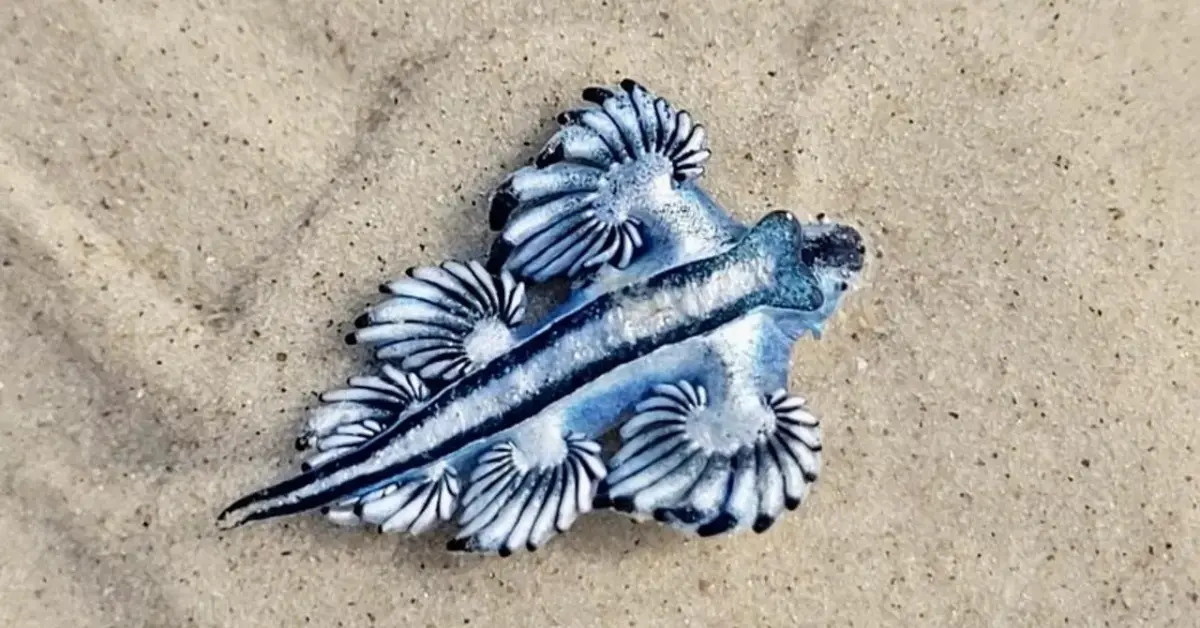Blue Dragons Texas Beaches
Beachgoers in Galveston, Texas may encounter a fascinating sight this spring: the mesmerizing blue dragon. These aren’t mythical creatures, but rather beautiful sea slugs (Glaucus Atlanticus) with a surprising punch. While their vibrant blue bodies with silvery appendages are captivating, it’s crucial to remember they pack a powerful sting.
Recent sightings have been reported along the Texas coast, from Galveston to Port Aransas. These delicate creatures are typically found in open ocean waters, but strong currents or storms can wash them ashore.
Blue Dragons on Texas Beaches: Look, Don’t Touch
The blue dragon’s alluring looks belie its danger. They lack the stinging cells themselves, but here’s the twist: they feed on venomous jellyfish-like organisms, particularly the Portuguese man o’ war. The blue dragon cleverly concentrates the stinging cells from its prey in its appendages, essentially wielding stolen venom for defense.
A sting from a blue dragon can be quite painful, reportedly several times worse than a man o’ war encounter. Symptoms can include intense burning, welts, and in severe cases, even respiratory issues. One can also experience excruciating pain, nausea, and vomiting.
They are beautiful, dangerous and almost otherworldly. Why this "blue dragon" that washed up on a Texas beach is a frightening find. pic.twitter.com/AXiadrcMvh
— Pattrn (@pattrn) May 16, 2020
Enjoying the Texas Beach Safely
If you spot a blue dragon on the shore, admire it from a distance. Remember, these beautiful creatures are wild animals and should not be touched. Here are some additional tips for a safe and enjoyable beach experience:
- Keep an eye out: Be aware of your surroundings, especially during spring when sightings are more frequent.
- Supervise children: Educate children about the dangers of touching unfamiliar sea creatures.
- Don’t pick them up: It might seem tempting to pick up these fascinating beings, but resist the urge.
- Treatment for stings: If unfortunately stung, seek medical attention immediately. First aid typically involves flushing the wound with vinegar or seawater and applying heat.
The presence of blue dragons shouldn’t deter you from enjoying the Texas coastline. With a little caution and awareness, you can ensure a safe and memorable beach adventure.
What are Blue Dragons?
Blue Dragons, scientifically known as Glaucus atlanticus, are striking marine creatures that belong to the family Glaucidae. Despite their small size, typically around 1 to 3 centimeters, these vibrant sea slugs capture attention with their striking blue and silver coloration. Found in warm oceanic waters, including the Atlantic and Pacific Oceans, Blue Dragons are known for their unique appearance and intriguing behavior.
Look but don't touch!
— Pattrn (@pattrn) December 4, 2020
This beautiful "blue dragon" washed up on Fish Hoek Beach in South Africa. This sea slug preys on Portuguese man o' wars and can store and concentrate its victims' toxins in stinging cells. So if you touch it, it delivers a jellyfish-like sting. pic.twitter.com/sPmohlyh3k
Characteristics of Blue Dragons
Coloration: Blue Dragons exhibit a mesmerizing blue hue on their dorsal side, while their ventral side is silver. This coloration serves a dual purpose of camouflage – the blue side blends with the ocean surface when viewed from above, while the silver side mimics the reflective surface of the water when seen from below.
Physiology: These sea slugs possess a flattened body with cerata (finger-like projections) on their back, which store the stinging cells (nematocysts) obtained from their prey, such as Portuguese Man o’ Wars. This adaptation allows them to utilize the venomous cells for their own defense.
Feeding Behavior: Blue Dragons are carnivorous and primarily feed on cnidarian organisms like jellyfish. Despite their small size, they are capable of delivering a powerful sting to their prey.
Blue Dragons: Sting Prevention and Treatment
Encounters with Blue Dragons can pose a risk of stings to beachgoers. If stung, here are essential steps to take:
Avoid Rubbing: Refrain from rubbing the affected area with hands or towels, as it can lead to further nematocyst discharge.
Rinse with Seawater: Wash the affected area with seawater to remove any remaining nematocysts. Avoid using freshwater, as it can trigger the release of more venom.
Vinegar Application: If available, vinegar can be applied to the affected area. Vinegar may help neutralize the toxins and prevent the nematocysts from releasing more venom.
Hot Water Soak: Soaking the affected area in hot water (not scalding) for 20-45 minutes may help alleviate pain and reduce symptoms. Hot water can help inactivating toxins.
Medical Attention: Seek medical attention if the pain persists or if there are signs of an allergic reaction, such as difficulty breathing or swelling.
Given the potential encounters with Blue Dragons Texas Beaches, it is crucial for beachgoers to be aware of these creatures and understand the precautions to take. Educating children and fellow beach enthusiasts about the presence of Blue Dragons and the importance of avoiding contact can contribute to safer beach experiences.
Content Contributor: Juhi Saluja









